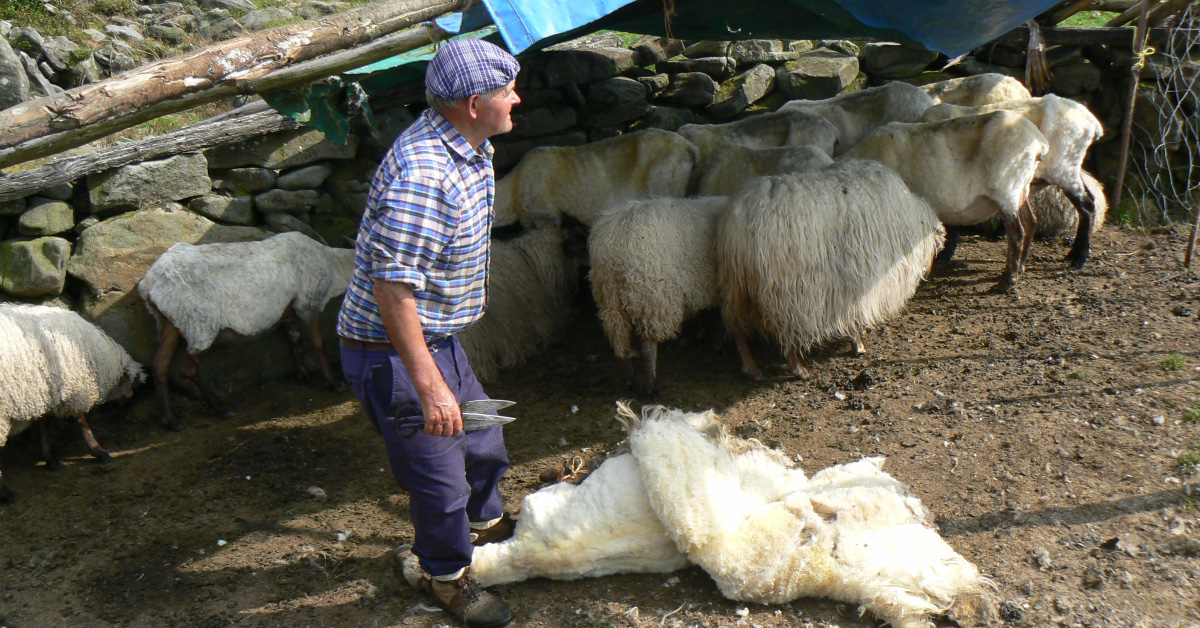Basque ethnography at a glance
Jose Ereño, a shepherd from Orozko, who has been the subject of a previous blog, published on 26 June 2020, finishes making the cheeses and begins to shear his sheep between the second fortnight of June and the first two weeks of July. By June, José and the other shepherds have already made their way up to Gorbeia, where the shearing takes place later than in the lower pastures as it is cooler up there.
He starts work early, before daybreak, as he knows that he needs to take advantage of the cool morning, before the sun begins to heat up. Anyhow, he has built a roof out of interwoven beech branches as protection from the sun.
Jose explains that shearing causes a significant change in temperature in the ewe’s body and care has to be taken to make sure that the animals do not get chilled during the first weeks. He also takes care not to leave the wool too short, rapera as he calls it, and also not to cut the new growth, to keep them warm and more protected.
He also follows a certain order: first, shearing hoggets (arkaztak) between one and two years old, then ewes without lambs (balderak), and finally the ewes with suckling lambs, which are sheared later. The last sheep to be sheared are that spring’s lambs, azuriak, at around four months old. Otherwise, some of the mothers may not recognise their young and reject them.
Jose usually gathers them in the pen the evening before so they have not eaten before being sheared, which makes them easier to handle. Being enclosed in a small place makes them sweat, which also makes the work easier. He takes them one by one to the shade to make the work more bearable.

Shearing the Ubixeta flock. Mount Gorbeia, June 2012. Martzelo Iza. Labayru Fundazioa Photography Archive.
He grasps the sheep by the neck with one arm and puts the other around the animal’s belly. He can then sit the ewe on her hind quarters and with her back against the shearer’s legs. As the ewe has no support, she usually remains still. The shearer begins by shearing the jowl and then the belly. Jose remembers that he started to learn his trade by helping his father when he was around ten years old.
He ties her four legs in a cross to stop the sheep from moving. He rolls the ewe over and first shears one side and then the other until he has managed to remove the wool as a single sheepskin. He also trims their fringes, mototsa, with great care. Even though each ewe is different, each sheepskin weighs between two and three kilos; two or three kilos less of wool per sheep to deal with the summer heat.
At the same time, he trims the hooves, checks the legs and sends them through a dip of salt, bleach and copper sulphate.
The wool was traditionally kept in bags to then be sold. In the 1990s, for example, sheep wool was sold at ninety pesetas per kilo, around a euro for every two kilos. Shepherds would usually keep a sheepskin to make laces, trailak, stockings… There were years when nobody wanted the wool and it ended up being burnt.
Shepherds used to help each other during shearing. And at the end of the work, the flock’s owner used to thank the people who had come to help with a good meal. It was, undoubtedly, a reason to celebrate.
Itziar Rotaetxe
Herri Ondarea Department – Labayru Fundazioa
You can find further information in the volume on Livestock Farming and Shepherding of the Ethnographic Atlas of the Basque Country.


